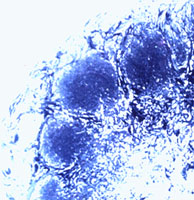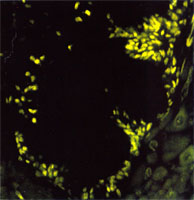|
|
Moth Math: Olfactory Cell Models in Manduca sexta The question that's being studied has puzzled anatomists for decades. "What do glial cells do?" Long known to play a role in the development of glomeruli, U of A reserchers wondered if glial cells also performed any functional role in the workings of the brain. The question that's being studied has puzzled anatomists for decades. "What do glial cells do?" Long known to play a role in the development of glomeruli, U of A reserchers wondered if glial cells also performed any functional role in the workings of the brain.
Glial cells surround glomeruli like a sack, with a "mouth" at the bottom of each glomerulus that remains uncovered. Researchers hypothesized that glial cells might serve as containers, preventing the spread of potassium ions discharged by each action potential. Too much potassium is thought to prevent subsequent "firings" of the Four different mathematical models were developed to determine what role glial cells might play in the re-absorption of potassium ions. If the glial cells formed an impermeable wall, potassium ions would only be able to exit the glomerulus through the bottom portion which remains uncovered. If instead, the glial cells acted as sponges, absorbing the potassium as it spread through the glomerulus, potassium uptake would happen much more quickly. Results of each model's simulations were compared to experimental data regarding the rate of "repeat firing" which can only happen once extra-cellular potassium concentration has dropped below a certain level.
|
 axons that make up each glomerulus.
axons that make up each glomerulus.